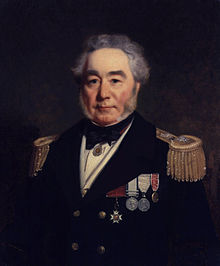Horatio Thomas Austin
| Sir Horatio Thomas Austin | |
|---|---|

Portrait of Horatio Thomas Austin by Stephen Pearce, 1860.
|
|
| Born | 1801 |
| Died | 16 November 1865 |
| Allegiance |
|
| Service/ |
|
| Rank | Vice Admiral |
| Commands held | Malta Dockyard |
Vice Admiral Sir Horatio Thomas Austin (1801 – 16 November 1865) was a British officer in the Royal Navy, and an explorer.
In 1828 HMS Chanticleer was dispatched on a scientific expedition in the Pacific Ocean under the command of Captain Henry Foster, with Austin as his First Lieutenant. Foster explored the South Atlantic, and especially the South Shetland Islands; Port Foster on Deception Island is named after him. He drowned in 1831 in the Chagres River in Panama. After Foster's loss, the ship's command fell to Austin. On the expedition, the ship circumnavigated along the Southern Hemisphere, visiting the River Plate and Isla de los Estados of Argentina, Cape Horn at the southernmost tip of South America, New Zealand, South Georgia, rounded the Cape of Good Hope near the southern tip of the African continent, and made port at Trinidad, before returning across the Atlantic Ocean to Falmouth in 1830.
Following the 1849 failure of James Clark Ross's attempt to locate the lost Franklin Expedition, Austin led an 1850 expedition that also attempted to find Sir John Franklin and his crew. George F. McDougall was second master on board HMS Resolute. Although the expedition located only traces of Franklin's presence, Austin is credited with organising successful sledging expeditions along the coasts of several Canadian Arctic islands, including Bathurst, Byam Martin, Melville, and Prince of Wales Island.
...
Wikipedia
